Gravitational assist
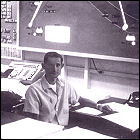 Recent Jet Propulsion Laboratory hire Michael Minovitch submits the first of a series of papers and technical memorandums on the possibility of using carefully-calculated gravitational assist maneuvers to speed transit time between celestial bodies while requiring minimal engine/fuel use. Where most previous scientific thought concentrated on using engine burns (and a lot of fuel) to cancel the effects of a planet’s gravity, Minovitch demonstrated that gravity could be a big help with a carefully calculated trajectory. Though nearly every planetary mission since then has capitalized on Minovitch’s research, it was initially rejected by JPL. Minovitch’s calculations are later revisited by Caltech grad student Gary Flandro, who flags down a particular combination of Minovitch’s pre-computed trajectories for a “grand tour” of the outer solar system, a mission which will eventually be known – in a somewhat scaled-down, less grand form – as Voyager.
Recent Jet Propulsion Laboratory hire Michael Minovitch submits the first of a series of papers and technical memorandums on the possibility of using carefully-calculated gravitational assist maneuvers to speed transit time between celestial bodies while requiring minimal engine/fuel use. Where most previous scientific thought concentrated on using engine burns (and a lot of fuel) to cancel the effects of a planet’s gravity, Minovitch demonstrated that gravity could be a big help with a carefully calculated trajectory. Though nearly every planetary mission since then has capitalized on Minovitch’s research, it was initially rejected by JPL. Minovitch’s calculations are later revisited by Caltech grad student Gary Flandro, who flags down a particular combination of Minovitch’s pre-computed trajectories for a “grand tour” of the outer solar system, a mission which will eventually be known – in a somewhat scaled-down, less grand form – as Voyager.

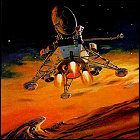 Following up on preliminary studies assuming almost-Earthlike conditions, NASA commences work on a major robotic interplanetary landing mission called Voyager, which will use a Saturn IB rocket to send an orbiter with two landers to Mars. But NASA is doing so without much help from its usual interplanetary think-tank, Jet Propulsion Laboratory, whose scientists warn NASA that the latest astronomical data suggests a significantly thinner atmosphere and lower atmospheric pressure than the scenario for which NASA is designing its vehicles. As the complexity involved in creating self-guided landers with on-board laboratories increases, contractors begin to insist that only a Saturn V will do; since all Saturn V boosters are currently in reserve for Apollo lunar missions, NASA pushes the Voyager mission back into the 1970s.
Following up on preliminary studies assuming almost-Earthlike conditions, NASA commences work on a major robotic interplanetary landing mission called Voyager, which will use a Saturn IB rocket to send an orbiter with two landers to Mars. But NASA is doing so without much help from its usual interplanetary think-tank, Jet Propulsion Laboratory, whose scientists warn NASA that the latest astronomical data suggests a significantly thinner atmosphere and lower atmospheric pressure than the scenario for which NASA is designing its vehicles. As the complexity involved in creating self-guided landers with on-board laboratories increases, contractors begin to insist that only a Saturn V will do; since all Saturn V boosters are currently in reserve for Apollo lunar missions, NASA pushes the Voyager mission back into the 1970s.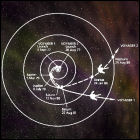 The Grand Tour Outer Planets mission is proposed to NASA by the Jet Propulsion Laboratory. Using a combination of the gravitational assist trajectories computed by JPL’s Michael Minovitch in
The Grand Tour Outer Planets mission is proposed to NASA by the Jet Propulsion Laboratory. Using a combination of the gravitational assist trajectories computed by JPL’s Michael Minovitch in 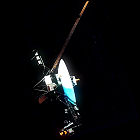 Having spent six years wrangling with various mission profiles for a “Grand Tour” of the outer solar system, made possible by a favorable planetary alignment occurring only once every 175 years, NASA finally authorizes a very stripped-down version of its original ambitious Grand Tour plans. The Mariner Jupiter/Saturn ’77 mission will consist of two twin unmanned spacecraft to be launched in
Having spent six years wrangling with various mission profiles for a “Grand Tour” of the outer solar system, made possible by a favorable planetary alignment occurring only once every 175 years, NASA finally authorizes a very stripped-down version of its original ambitious Grand Tour plans. The Mariner Jupiter/Saturn ’77 mission will consist of two twin unmanned spacecraft to be launched in 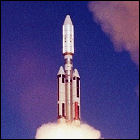 In advance of the Viking and Voyager interplanetary missions, which will need more powerful boosters to heft heavier spacecraft into deep space, NASA conducts a test launch of the Titan IIIe/Centaur launch stack, an experimental combination of the venerable Titan rocket and a liquid-fueled Centaur upper stage. Previous Centaur upper stages were attached to wider Atlas rockets, so the unusual bulb-shaped payload shroud of the Centaur is of concern when placed atop the Titan, which has a more narrow diameter; if successful, however, this configuration could launch payloads three times larger than an Atlas/Centaur combination. The test flight, originally scheduled for January 24th, actually fails – a loose part causes the Centaur stage to fizzle rather than fire – and the rocket is destroyed in mid-air. However, with worries about the large Centaur payload atop the narrow Titan rocket laid to rest, NASA approves the Titan IIIe/Centaur for flight, beginning with the launch of a joint American/German science satellite, HELIOS-1, later in 1974.
In advance of the Viking and Voyager interplanetary missions, which will need more powerful boosters to heft heavier spacecraft into deep space, NASA conducts a test launch of the Titan IIIe/Centaur launch stack, an experimental combination of the venerable Titan rocket and a liquid-fueled Centaur upper stage. Previous Centaur upper stages were attached to wider Atlas rockets, so the unusual bulb-shaped payload shroud of the Centaur is of concern when placed atop the Titan, which has a more narrow diameter; if successful, however, this configuration could launch payloads three times larger than an Atlas/Centaur combination. The test flight, originally scheduled for January 24th, actually fails – a loose part causes the Centaur stage to fizzle rather than fire – and the rocket is destroyed in mid-air. However, with worries about the large Centaur payload atop the narrow Titan rocket laid to rest, NASA approves the Titan IIIe/Centaur for flight, beginning with the launch of a joint American/German science satellite, HELIOS-1, later in 1974.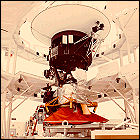 NASA Administrator James Fletcher announces that the ambitious twin Mariner Jupiter/Saturn ’77 space probes, due to be launched later in the year, have been christened with new names: Voyager 1 and Voyager 2. The name change has been initiated by recently-promoted Voyager program manager John Casani, who thinks the spacecraft need a name that’s less of a mouthful (the name “Discoverer” was also considered). For the first time, NASA openly admits that one of the vehicles – Voyager 2 – may continue on to Uranus and Neptune should its Saturn flyby go well in 1981, depending on the spacecraft’s health.
NASA Administrator James Fletcher announces that the ambitious twin Mariner Jupiter/Saturn ’77 space probes, due to be launched later in the year, have been christened with new names: Voyager 1 and Voyager 2. The name change has been initiated by recently-promoted Voyager program manager John Casani, who thinks the spacecraft need a name that’s less of a mouthful (the name “Discoverer” was also considered). For the first time, NASA openly admits that one of the vehicles – Voyager 2 – may continue on to Uranus and Neptune should its Saturn flyby go well in 1981, depending on the spacecraft’s health.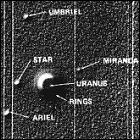 A team of MIT astronomers, flying in a plane modified to serve as an airborne high-altitude telescope, plans to observe the planet Uranus as it eclipses, or “occults”, a star. But the team observes more occultations than expected both before and after the planet itself passes in front of the star. The inevitable conclusion is that Uranus has rings, made of material too dark to be detected by existing Earthbound telescopes. Further observations are given top priority: NASA’s Voyager 2 space probe, due to lift off later in 1977, may last long enough to reach Uranus, and the newly discovered rings must be taken into account when planning its flyby trajectory.
A team of MIT astronomers, flying in a plane modified to serve as an airborne high-altitude telescope, plans to observe the planet Uranus as it eclipses, or “occults”, a star. But the team observes more occultations than expected both before and after the planet itself passes in front of the star. The inevitable conclusion is that Uranus has rings, made of material too dark to be detected by existing Earthbound telescopes. Further observations are given top priority: NASA’s Voyager 2 space probe, due to lift off later in 1977, may last long enough to reach Uranus, and the newly discovered rings must be taken into account when planning its flyby trajectory.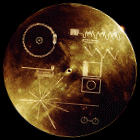 With less than a month to go before the launch of the first of two Voyager unmanned spacecraft, NASA attaches copper phonograph records, encased in lightweight, protective golden casings, to each of the Voyager probes. With participation from Carl Sagan (who led the effort to mount a plaque on the Pioneer probes consisting only of visual information), SETI pioneer Frank Drake, Jon Lomberg and others, the 12″ LP consists of not only sound recordings, but photos and diagrams depicting the diversity and composition of life on Earth. The sounds include various kinds of Earth wildlife, spoken messages from President Jimmy Carter and United Nations Secretary-General Kurt Waldheim, music from Beethoven and Bach to Chuck Berry (the Beatles decline permission to include “Here Comes The Sun”), and Carl Sagan’s young son Nick delcaring “Greetings from the children of planet Earth.” The outer casing includes a playback mechanism and diagrams for how to use it.
With less than a month to go before the launch of the first of two Voyager unmanned spacecraft, NASA attaches copper phonograph records, encased in lightweight, protective golden casings, to each of the Voyager probes. With participation from Carl Sagan (who led the effort to mount a plaque on the Pioneer probes consisting only of visual information), SETI pioneer Frank Drake, Jon Lomberg and others, the 12″ LP consists of not only sound recordings, but photos and diagrams depicting the diversity and composition of life on Earth. The sounds include various kinds of Earth wildlife, spoken messages from President Jimmy Carter and United Nations Secretary-General Kurt Waldheim, music from Beethoven and Bach to Chuck Berry (the Beatles decline permission to include “Here Comes The Sun”), and Carl Sagan’s young son Nick delcaring “Greetings from the children of planet Earth.” The outer casing includes a playback mechanism and diagrams for how to use it.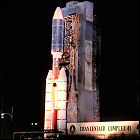 NASA launches Voyager 2 (weeks ahead of Voyager 1), giving the unmanned space probe the best shot of taking advantage of a favorable planetary alignment known as the “Grand Tour”. Using a series of carefully calculated gravity assists, Voyager has the potential to visit all four of the major outer gas planets – Jupiter, Saturn, Uranus and Neptune – in under 15 years without having to expend fuel to make the trip. If Voyager 2 survives long enough to visit Uranus or Neptune, it will become the first man-made spacecraft to visit either planet.
NASA launches Voyager 2 (weeks ahead of Voyager 1), giving the unmanned space probe the best shot of taking advantage of a favorable planetary alignment known as the “Grand Tour”. Using a series of carefully calculated gravity assists, Voyager has the potential to visit all four of the major outer gas planets – Jupiter, Saturn, Uranus and Neptune – in under 15 years without having to expend fuel to make the trip. If Voyager 2 survives long enough to visit Uranus or Neptune, it will become the first man-made spacecraft to visit either planet.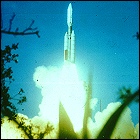 The unmanned robotic
The unmanned robotic 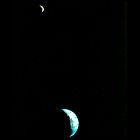 Barely two weeks after launch, Voyager 1 captures the first-ever photo of the Earth and its moon in their entirety, from a distance of just over seven million miles. Due to the moon’s relatively low visibility, JPL has to “brighten” the moon so it’s visible in the photo. Voyager 1 soon loses sight of Earth and the moon as it speeds toward Jupiter, a planet it won’t reach until 1979.
Barely two weeks after launch, Voyager 1 captures the first-ever photo of the Earth and its moon in their entirety, from a distance of just over seven million miles. Due to the moon’s relatively low visibility, JPL has to “brighten” the moon so it’s visible in the photo. Voyager 1 soon loses sight of Earth and the moon as it speeds toward Jupiter, a planet it won’t reach until 1979.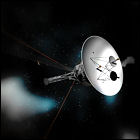 NASA announces that Voyagers 1 and 2 may be in a unique position to study the newly-discovered Comet Kohler 1977 XIV, discovered just days before Voyager 1’s launch. Both Voyagers are expected to pass Comet Kohler at a distance of a little over 1 astronomical unit (AU), equivalent to the distance between Earth and the Sun, in November, and the possibility of examining the comet with their onboard instruments is proposed. This plan is eventually abandoned, since the comet will track near the sun, direct exposure to which could harm the television tube cameras installed aboard each Voyager. The exploration of comets with robotic spacecraft will have to wait until the 1980s.
NASA announces that Voyagers 1 and 2 may be in a unique position to study the newly-discovered Comet Kohler 1977 XIV, discovered just days before Voyager 1’s launch. Both Voyagers are expected to pass Comet Kohler at a distance of a little over 1 astronomical unit (AU), equivalent to the distance between Earth and the Sun, in November, and the possibility of examining the comet with their onboard instruments is proposed. This plan is eventually abandoned, since the comet will track near the sun, direct exposure to which could harm the television tube cameras installed aboard each Voyager. The exploration of comets with robotic spacecraft will have to wait until the 1980s.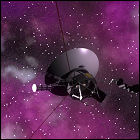 NASA’s Voyager 1 space probe, en route to its first destination, develops a potentially mission-jeopardizing problem: the scan platform, which contains and aims many of Voyager’s scientific instruments, jams and becomes stuck in place. As Voyager 1 has yet to even reach Jupiter, this threatens to make it an expensive failure. Transmitting commands from Earth to give the scan platform a gentle three-axis workout, engineers at NASA manage to free the stuck instruments, salvaging Voyager 1’s mission to the outer planets and their moons. (A similar fault develops in Voyager 2 during its 1981 encounter with Saturn.)
NASA’s Voyager 1 space probe, en route to its first destination, develops a potentially mission-jeopardizing problem: the scan platform, which contains and aims many of Voyager’s scientific instruments, jams and becomes stuck in place. As Voyager 1 has yet to even reach Jupiter, this threatens to make it an expensive failure. Transmitting commands from Earth to give the scan platform a gentle three-axis workout, engineers at NASA manage to free the stuck instruments, salvaging Voyager 1’s mission to the outer planets and their moons. (A similar fault develops in Voyager 2 during its 1981 encounter with Saturn.)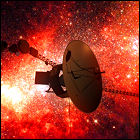 Following a communications blackout scare in April 1978, JPL uploads an autonomous command sequence to the Voyager 2 unmanned space probe, which would allow the spacecraft to carry out a self-guided mission to Jupiter and Saturn, the results of which would automatically be transmitted to Earth even if Voyager 2 can receive no further instructions from Earth. Due to the command storage limitations of Voyager 2’s onboard computer, this automatic backup mission plan makes no allowances for pictures of Jupiter, saving that capability for Saturn instead. In the event that Voyager 2 can no longer hear commands from Earth, the extended mission to Uranus and Neptune would be forfeited in favor of “minimum science return” from Jupiter and Saturn.
Following a communications blackout scare in April 1978, JPL uploads an autonomous command sequence to the Voyager 2 unmanned space probe, which would allow the spacecraft to carry out a self-guided mission to Jupiter and Saturn, the results of which would automatically be transmitted to Earth even if Voyager 2 can receive no further instructions from Earth. Due to the command storage limitations of Voyager 2’s onboard computer, this automatic backup mission plan makes no allowances for pictures of Jupiter, saving that capability for Saturn instead. In the event that Voyager 2 can no longer hear commands from Earth, the extended mission to Uranus and Neptune would be forfeited in favor of “minimum science return” from Jupiter and Saturn.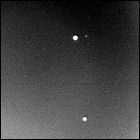 Voyager 1 emerges unharmed from what is considered the outer limit of the asteroid belt between Mars and Jupiter, having entered this 223,000,000-mile-wide zone of space in December 1977. Voyager 2 is expected to emerge similarly unscathed in late October 1978. NASA’s Pioneer 10 and 11 spacecraft had already demonstrated, in the early 1970s, that passage through the asteroid belt without mission-jeopardizing damage is possible. Both spacecraft are already imaging Jupiter from a distance of less than 180,000,000 miles, now meeting or exceeding the resolution of the best photos of Jupiter taken from Earth-based telescopes.
Voyager 1 emerges unharmed from what is considered the outer limit of the asteroid belt between Mars and Jupiter, having entered this 223,000,000-mile-wide zone of space in December 1977. Voyager 2 is expected to emerge similarly unscathed in late October 1978. NASA’s Pioneer 10 and 11 spacecraft had already demonstrated, in the early 1970s, that passage through the asteroid belt without mission-jeopardizing damage is possible. Both spacecraft are already imaging Jupiter from a distance of less than 180,000,000 miles, now meeting or exceeding the resolution of the best photos of Jupiter taken from Earth-based telescopes.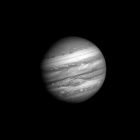 From a distance of 36 million miles, NASA/JPL’s unmanned spacecraft Voyager 1 can already see the planet Jupiter in far greater detail than the cameras aboard Pioneers 10 and 11. Over the next month, Voyager 1 records images as it closes in on its first planetary target, spotting roiling storm clouds and fluid cloud bands with unprecedented clarity; JPL assembles the images into a “movie.” Despite the size of Jupiter at the end of the sequence, Voyager 1 is still over a month away from its closest pass to the giant planet.
From a distance of 36 million miles, NASA/JPL’s unmanned spacecraft Voyager 1 can already see the planet Jupiter in far greater detail than the cameras aboard Pioneers 10 and 11. Over the next month, Voyager 1 records images as it closes in on its first planetary target, spotting roiling storm clouds and fluid cloud bands with unprecedented clarity; JPL assembles the images into a “movie.” Despite the size of Jupiter at the end of the sequence, Voyager 1 is still over a month away from its closest pass to the giant planet.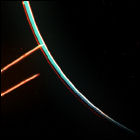 As it nears its closest approach to the planet Jupiter, NASA’s Voyager 1 space probe detects the first likely signs of a ring system around Jupiter’s equatorial region. Barely visible until Voyager 1 is behind the planet and can see them through scattered sunlight, the rings are only about 20 miles thick, but are over 150,000 miles in diameter. The lead time between Voyager 1’s visit and Voyager 2’s later flyby allows ground controllers to plan a better observation campaign for Voyager 1’s sister ship, and the rings are observed in more detail by the later Galileo and New Horizons missions.
As it nears its closest approach to the planet Jupiter, NASA’s Voyager 1 space probe detects the first likely signs of a ring system around Jupiter’s equatorial region. Barely visible until Voyager 1 is behind the planet and can see them through scattered sunlight, the rings are only about 20 miles thick, but are over 150,000 miles in diameter. The lead time between Voyager 1’s visit and Voyager 2’s later flyby allows ground controllers to plan a better observation campaign for Voyager 1’s sister ship, and the rings are observed in more detail by the later Galileo and New Horizons missions.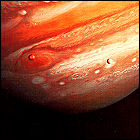 The unmanned NASA/JPL space probe Voyager 1 makes its closest approach to the giant planet Jupiter, a little over 200,000 miles away. While Voyager’s higher-resolution cameras trump any of the Pioneer images of Jupiter, the real revelation proves to be Jupiter’s four largest moons, revealing a smooth-but-cracked icy surface on Europa, craters on Ganymede and Callisto, and the colorful mountains of Io, whose biggest secret goes undiscovered until a few days after Voyager 1’s closest flyby.
The unmanned NASA/JPL space probe Voyager 1 makes its closest approach to the giant planet Jupiter, a little over 200,000 miles away. While Voyager’s higher-resolution cameras trump any of the Pioneer images of Jupiter, the real revelation proves to be Jupiter’s four largest moons, revealing a smooth-but-cracked icy surface on Europa, craters on Ganymede and Callisto, and the colorful mountains of Io, whose biggest secret goes undiscovered until a few days after Voyager 1’s closest flyby.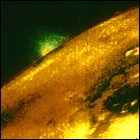 JPL navigation engineer Linda Morabito, double-checking raw Voyager 1 images to ensure that the unmanned space probe is properly aligned for its encounter with Saturn in 1980, discovers the first evidence of active volcanoes on another body in Earth’s solar system: a plume of sulfur erupting over 150 feet above the surface of Jupiter’s moon Io. Scientists rush to check Voyager 1’s other Io images, and find that Voyager’s cameras caught more than half a dozen eruptions in the act.
JPL navigation engineer Linda Morabito, double-checking raw Voyager 1 images to ensure that the unmanned space probe is properly aligned for its encounter with Saturn in 1980, discovers the first evidence of active volcanoes on another body in Earth’s solar system: a plume of sulfur erupting over 150 feet above the surface of Jupiter’s moon Io. Scientists rush to check Voyager 1’s other Io images, and find that Voyager’s cameras caught more than half a dozen eruptions in the act.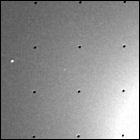 Tiny Adrastea, a small, asteroid-like moon of Jupiter, is discovered in photos returned by Voyager 2 during its flyby of the planet. Adrastea orbits along the outer edge of Jupiter’s ring system, and is likely to be the body from which material for that ring is ejected. Its close orbit carries it around the planet at a speed faster than Jupiter’s rotation, one of the few bodies in the solar system locked into such a fast orbit.
Tiny Adrastea, a small, asteroid-like moon of Jupiter, is discovered in photos returned by Voyager 2 during its flyby of the planet. Adrastea orbits along the outer edge of Jupiter’s ring system, and is likely to be the body from which material for that ring is ejected. Its close orbit carries it around the planet at a speed faster than Jupiter’s rotation, one of the few bodies in the solar system locked into such a fast orbit.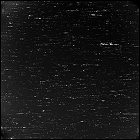 NASA temporarily loses contact with unmanned space probe Voyager 1 as it cruises toward Saturn. A science experiment is conducted which requires Voyager to point its antenna away from Earth and enter a rolling maneuver, but ground controllers do not hear back from Voyager 1 when they expect to receive the signal that the experiment has ended. A tracking station in Australia sends a wide-beam command to Voyager 1 to reorient itself; it is later discovered that, attempting to regain its orientation with respect to Earth, Voyager 1’s star tracker locked on to Alpha Centauri instead of Canopus, pointing its antenna dish five degrees away from Earth. Normal operations resume once Voyager is pointed correctly. A similar problem will again cause Voyager 1 to break contact after a course correction burn in December.
NASA temporarily loses contact with unmanned space probe Voyager 1 as it cruises toward Saturn. A science experiment is conducted which requires Voyager to point its antenna away from Earth and enter a rolling maneuver, but ground controllers do not hear back from Voyager 1 when they expect to receive the signal that the experiment has ended. A tracking station in Australia sends a wide-beam command to Voyager 1 to reorient itself; it is later discovered that, attempting to regain its orientation with respect to Earth, Voyager 1’s star tracker locked on to Alpha Centauri instead of Canopus, pointing its antenna dish five degrees away from Earth. Normal operations resume once Voyager is pointed correctly. A similar problem will again cause Voyager 1 to break contact after a course correction burn in December.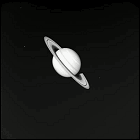 With the Jupiter encounter behind it, NASA’s Voyager 2 unmanned spacecraft is given a new backup mission plan, replacing the original Jupiter/Saturn backup plan implemented after a radio receiver failure befell the spacecraft in 1978. Intended to reap the minimum acceptable science observations (including photography) and transmit them to Earth should Voyager 2’s ability to receive new commands be lost, this new backup mission load now includes automated observation plans for Saturn and Uranus, the latter of which will not be reached until 1986.
With the Jupiter encounter behind it, NASA’s Voyager 2 unmanned spacecraft is given a new backup mission plan, replacing the original Jupiter/Saturn backup plan implemented after a radio receiver failure befell the spacecraft in 1978. Intended to reap the minimum acceptable science observations (including photography) and transmit them to Earth should Voyager 2’s ability to receive new commands be lost, this new backup mission load now includes automated observation plans for Saturn and Uranus, the latter of which will not be reached until 1986. Thanks to a significant gravity assist from Jupiter, Voyager 1 arrives at Saturn only a year behind Pioneer 11, imaging the planet, its rings and its moons in far greater detail. Its planned trajectory takes Voyager 1 close to the cloud-shrouded moon Titan, whose surface scientists hope to be able to see for the first time, but the close flyby yields only the featureless clouds, much to the mission planners’ disappointment. This is Voyager 1’s final planetary stop, with a proposed visit to Pluto having fallen by the wayside early in mission planning in favor of the close-up look at Titan.
Thanks to a significant gravity assist from Jupiter, Voyager 1 arrives at Saturn only a year behind Pioneer 11, imaging the planet, its rings and its moons in far greater detail. Its planned trajectory takes Voyager 1 close to the cloud-shrouded moon Titan, whose surface scientists hope to be able to see for the first time, but the close flyby yields only the featureless clouds, much to the mission planners’ disappointment. This is Voyager 1’s final planetary stop, with a proposed visit to Pluto having fallen by the wayside early in mission planning in favor of the close-up look at Titan.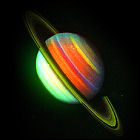 The NASA/JPL unmanned space probe Voyager 2 makes its closest pass to the planet Saturn. Unlike Voyager 1, Voyager 2 does not make a close pass to the large moon Titan, and uses Saturn’s gravity to deflect it toward the planet Uranus, the first man-made spacecraft to aim for that planet. Problems with the aiming mechanism of the scan platform – the arm of the spacecraft containing Voyager’s camera and imaging systems – call the viability of a Uranus flyby into question for a short time, but the issue is resolved and workaround procedures are developed in the event of a recurring problem.
The NASA/JPL unmanned space probe Voyager 2 makes its closest pass to the planet Saturn. Unlike Voyager 1, Voyager 2 does not make a close pass to the large moon Titan, and uses Saturn’s gravity to deflect it toward the planet Uranus, the first man-made spacecraft to aim for that planet. Problems with the aiming mechanism of the scan platform – the arm of the spacecraft containing Voyager’s camera and imaging systems – call the viability of a Uranus flyby into question for a short time, but the issue is resolved and workaround procedures are developed in the event of a recurring problem.